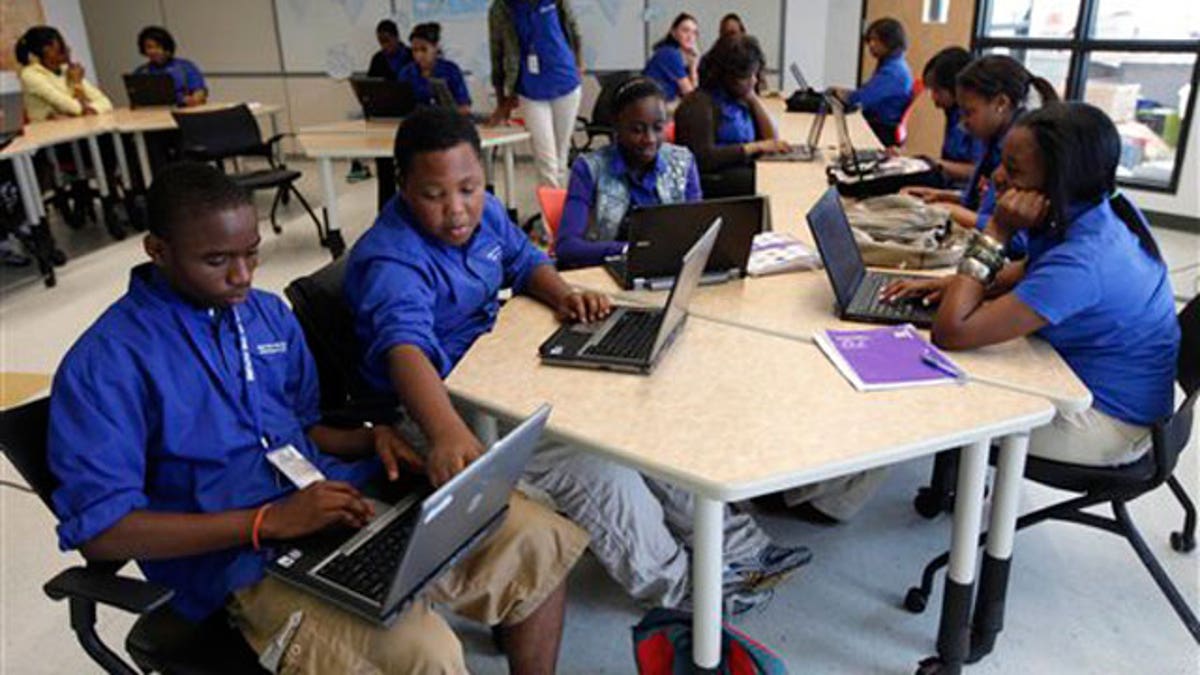
May 20: students use laptop computers in the classroom at the 'School of the Future' in Philadelphia. (AP)
PHILADELPHIA – PHILADELPHIA (AP) — When the Microsoft-designed School of the Future opened, the facility was a paragon of contemporary architecture, with a green roof, light-filled corridors and the latest classroom technology, all housed in a dazzling white modern building.
It might as well have been a fishbowl: Educators and media from around the world watched to see whether Microsoft could reform public education through innovation and technology.
Although the school's creative ambitions have been frustrated by high principal turnover, curriculum tensions and a student body unfamiliar with laptop computer culture, the school graduates its first senior class Tuesday with each student having been accepted to an institution of higher learning.
"The first three years were definitely a challenge," said Mary Cullinane, Microsoft's liaison to the school. "They're hitting they're groove now. I'm excited to see what's in store."
From the beginning, everything about the $63 million School of the Future was designed to be different.
Built in the city's rough Parkside section with district money, the school partnered with Microsoft on new approaches to curriculum, instruction and hiring. It attracted reform-minded teachers and students bent on avoiding traditional high schools.
The vision was for a paperless, textbook-less school that embodied the motto "Continuous, Relevant, Adaptive." Each student would get a take-home laptop on which to keep notes, do homework and take tests.
But learners are chosen by a lottery of public school students. Most are low-income and without home computers, yet they are expected to manage their high school careers on a laptop.
"I felt kind of awkward," said senior Kenneth Bolds, 17. "I was used to using books and pencils for eight years."
Educators also assumed learners would enter the school performing at grade level, but half the students in the academically troubled district are not proficient at reading or math.
The school's first set of standardized test scores last year were dismal. Only 7.5 percent of 11th graders scored proficient or higher in math; 23.4 percent scored proficient or higher in reading.
Cullinane notes that the school can't control students' education before ninth grade, but said test scores don't tell the whole story.
"It is a long-term journey and we have to get away from short-term yardsticks," she said.
The project-based curriculum also caused problems because it did not translate to district benchmarks. Its interdisciplinary nature made it hard to tell what material had been taught, said Nancy Hopkins-Evans, special assistant to the district's chief academic officer.
"Our issue was that you had content and standards that you absolutely needed to cover," Hopkins-Evans said.
Report cards, too, were incompatible with the district's needs. The narrative assessments rated students from "Advanced" to "Not on the Radar" instead of giving letter grades. And the idea to replicate a professional work day by using a 9 a.m. to 4 p.m. schedule had to be altered; some students needed the traditional school day.
All the while, there were tours, tours, tours. More than 3,000 people from 50 countries have visited the school, said Cullinane, worldwide director of innovation for Microsoft Education.
Senior Mahcaiyah Wearing-Gooden, 18, said she led countless tours as a freshman, showing off computerized blackboards ("smart boards") and digital lockers that popped open by waving an ID card.
"It was a lot to process at the time," she said.
Principal Rosalind Chivis — the school's fourth — described the building's journey as "trying to build a plane while flying it."
Yet now, she said, a revamped curriculum, steady leadership and better use of resources and scheduling has yielded the "first full year of uninterrupted education."
Teacher Aruna Arjunan said part of the school's strength lies in offering a combination of academic, technical and real-world skills.
Students' familiarity with Microsoft programs make them employable straight out of high school, she said. They are also evaluated on "competencies" that Seattle-based Microsoft uses with its own employees, such as dealing with ambiguity and thinking on the fly.
"There are kids in this building who would have flunked out of other high schools," Arjunan said. "I just think the culture here is unlike any other."
All 117 seniors were accepted to post-secondary programs, from community colleges to selective schools like Villanova University; however, 11 of them must attend summer school to graduate.
Some students, like Wearing-Gooden, weren't even considering college as freshmen. But this fall, Wearing-Gooden will be studying climatology on a scholarship at Green Mountain College in Vermont.
She said she realized her potential at the School of the Future, which offered individual attention, a supportive atmosphere and a familial dynamic. The hectic first years also taught Wearing-Gooden a valuable life lesson.
"It showed me that the world is not as stable as we want it to be," she said. "Now I'm ready for anything."
___
Online:
School of the Future/Microsoft: http://tinyurl.com/lm7qn2
School of the Future/District: http://tinyurl.com/24phxnt

